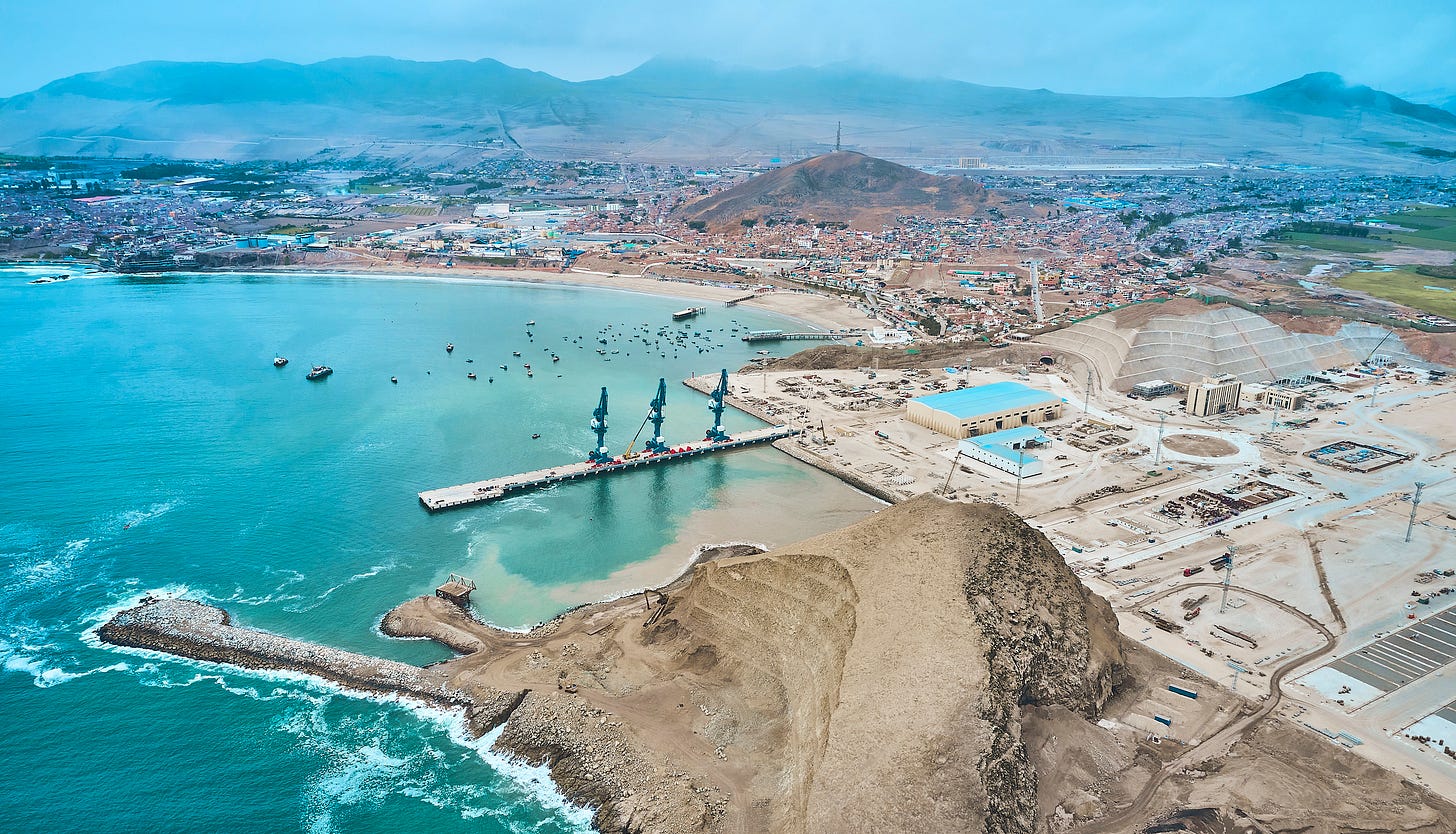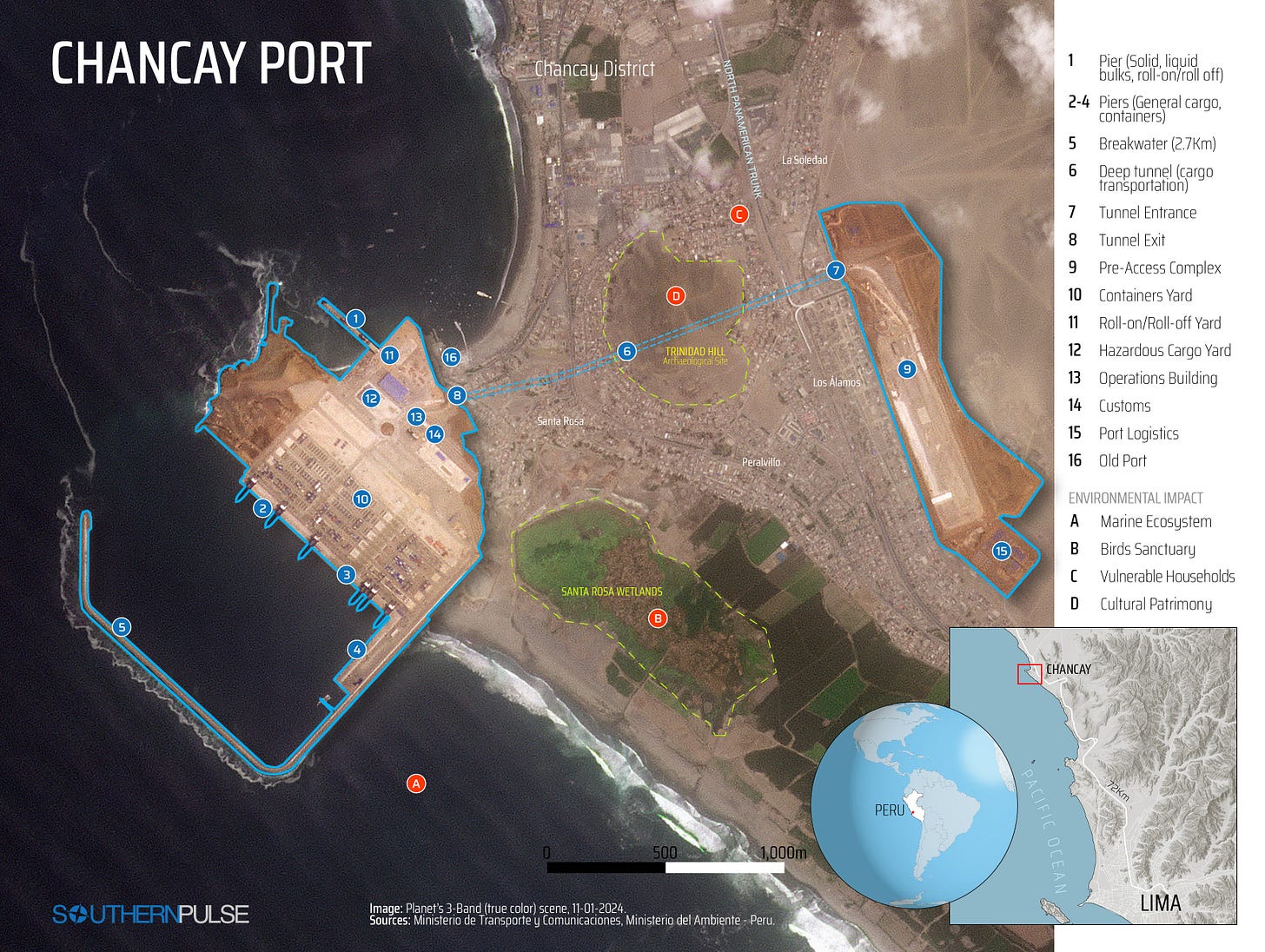The new Chancay “megaport” north of Lima has opened a debate about the Peruvian state’s institutional capacity to deal with the tension between economic progress and environmental sustainability.
The new deepwater port terminal about 70 kilometers north of Peru’s capital was inaugurated on November 14. It is already the largest seaport in Peru, surpassing the size and capacity of Lima’s El Callao port already serving the country’s entire central coastal region. Chancay is expected to start commercial operations in February 2025, Bloomberg Línea reported.
Opinions are divided in Peru on the new port. Business and political sectors have big expectations about the economic benefits that strengthened international trade will bring to the country. However, some community and environmental organizations have opposed the port for its potential environmental impacts. The project has also generated controversy within the Peruvian government because it grants exclusivity of essential services to COSCO Shipping Ports Chancay Peru, which is majority-owned by Hong Kong-based COSCO Shipping Ports.
First Impact
The Chancay Multipurpose Port Terminal in Chancay, a district in Huaral Province, has been in the making for 20 years. The project started growing beyond its original scope in 2019, when COSCO Shipping Ports acquired 60%. Peru’s Volcan Mining Company owns the remainder.
After securing permission from Peru’s National Port Authority (APN) to start the first phase of the megaport, COSCO requested an extension of the project's maritime area to construct a 2.7-kilometer breakwater. The project now spans a 4.3 million square-meter area, which includes cargo terminals and land for logistics operations in addition to ocean access points and shorelines.
The nearby urban landscape required the port’s developers to fragment the project into two major areas: the cargo staging area east of the city, and the port itself.
Chancay Trembles
While the National Environmental Certification Service (Senace) approved COSCO’s plan to construct the port, advocacy groups and environmental organizations quickly raised objections about the impacts of demolitions and potential changes to the marine ecosystem near the new port.
These concerns culminated in vocal complaints from local citizen groups and NGOs during an excavation effort to make way for a 1.8-kilometer-long access tunnel under several communities and a pre-Inca historical heritage site called Trinidad Hill. The controlled explosions caused several houses and a street to collapse.
Many people have also been displaced from their homes on El Cascajo Hill since 2020, when work began to expand the terminal’s administrative facilities by progressively clearing the area.
Several NGOs were born out of opposition to the project, including the Asociación en Defensa de las Viviendas del Puerto and Frente de Defensa por la Dignidad y Libertad de Chancay. The port opening ceremony during the Asia-Pacific Economic Cooperation (APEC) summit was held outside Lima for security reasons as groups protested in the capital, with several heads of state including China’s President Xi Jinping attending the meeting.
Environmental Concerns
Chancay is one of the mainstays of China’s New Silk Road project. The port terminal’s geographic location gives China great operational advantages over the most important Pacific Coast ports across the Americas.
China’s strategic commercial enclave will help it significantly cut shipping times between ports. COSCO plans to reduce the transit time for large cargo ships traveling between South America and Shanghai from 35 to 23 days. Mining exports from Chinese companies in Peru will be the first to benefit, with Chinese state-owned companies accounting for about 20% of the mining operations in the South American country.
Chilean outlet La Tercera also reported that COSCO has a competitive position against Chile’s San Antonio and Valparaíso ports — the busiest Pacific ports in South America to date.
China's growing influence through the Ocean Alliance (the world’s largest shipping network led by COSCO and its associates) and the Belt and Road Initiative global development strategy has also set off alarm bells about Chancay. Organizations like the US-based Center for Strategic and International Studies (CSIS) and the UK’s Bloomsbury Intelligence and Security Institute are worried about how China may strategically use its Western ports.
While the Chancay megaport provides opportunities to boost Peru’s economy, the country’s environmental organizations such as CooperAcción have frequently warned about the project’s environmental impact risks.
Several well-documented cases have raised concerns about the way Chinese infrastructure and mining companies approach environmental protection. Environmental groups, academics and indigenous sectors have alleged that Chinese companies have caused serious damage to natural areas near hydroelectric plants in Bolivia and Santa Cruz in Argentina, the San Carlos Panantza mine in Ecuador, and the Junín and Ayacucho oil fields in Venezuela’s Orinoco Mining Arc.
In August 2024, China recognized that its business activities have caused environmental damage in Latin America before the United Nations Human Rights Council during its Universal Periodic Review.
What is at Stake in Chancay
The Chancay port could particularly affect the Santa Rosa wetlands about 200 meters from the eastern end of the port. Peruvian biologists consider the ecosystem to be highly vulnerable to changes in the coastline that could arise due to the port’s new breakwater, as well as particulate matter emitted from the giant cargo yard.
According to a Peruvian Society of Environmental Law (SPDA) analysis published in 2023, the project still lacks “better standards that guarantee the protection” of a fragile natural space such as the Santa Rosa wetlands. Experts from the Pontificia Universidad Católica del Perú (PUCP) have also warned that this ecosystem’s health depends on the amount of human intervention in its environment, alterations in the region's biodiversity, and environmental impacts associated with urban and industrial activities.
Environmental specialists are also worried about the fauna at the bottom of Chancay’s waters, as the port could potentially alter the natural balance of biodiversity as local species migrate or disappear. These changes might also displace artisanal fishing, an important local economic activity.
These experts are also concerned because Chancay’s owners have not publicly released contingency plans about how the port would deal with any potential environmental accidents.
Residents and NGOs in the area still have a bitter memory of the 2022 Repsol oil spill in the area that affected Cascajo Beach next to the Santa Rosa wetlands. The Spanish energy multinational still has a pending debt of more than USD47 million for environmental remediation.
Whether Chancay’s owners have any environmental compensation plan for the port beyond government-approved impact studies is unclear.
“The absence of an environmental compensation plan for an investment project of such magnitude is alarming, despite the existence of a regulatory framework that provides for its consideration in the corresponding environmental management instrument,” warns the SPDA.
Although the wetland is not an officially protected ecosystem, it constitutes a nearly 79-hectare area that migratory birds use to nest. “With the operation of the port, the swell will change and affect the coast, causing the birds to move to other areas,” the PUCP explains.
“Chancay and Peru are experiencing social confusion due to the impacts of the megaport, due to the lack of preparation to face the economic, social and environmental dynamics that the link with the New Silk Road will bring,” the Chancay district’s Urban Development Plan (PDU for its Spanish acronym) wrote in an executive summary released under a public consultation process held weeks before the port’s inauguration.
The PDU, which is the legal framework for local development planning, is proposing an investment program of about USD1.3 billion. The funds would largely support development and planning activities in the Chancay region to confront urban challenges as the port expands.
The plan aims to correct a series of environmental, social and economic factors over the next decade, including concerns about the ability of local artisanal fisheries and farmers to adapt to the changing conditions. The PDU also considers the potential impacts on Chancay's archaeological sites and cultural heritage as official figures project that the district's population will increase from 65,000 inhabitants to an estimated 216,000.
President Dina Boluarte’s Transportation and Communications Ministry (MTC) is also allocating funds to improve Chancay's interurban roads to facilitate transit through an area that is projected to be a high-intensity land transportation zone.
Vulnerable Ecosystem, Fragile State
Several NGOs and experts have questioned whether Peru’s government can effectively regulate the port’s environmental and social impacts, as local officials did not begin drafting the PDU until 2023.
Along with bringing new economic opportunities to Peru, Chancay’s new megaport is expected to significantly change the surrounding region’s footprint. City officials now face potential challenges including a strain on public utilities, an increase in informal employment and housing shortages in the area near the port.
Meanwhile, COSCO has faced legal challenges to its exclusivity in providing essential services for the port. Ojo Público revealed details of an administrative authorization the APN granted to COSCO in February 2021, which contradicted the country's antitrust policies when it was made public three years later. The APN recognized that the economic exclusivity concession was an administrative mistake and requested that the government nullify it, but Reuters reported in June 2024 that a transportation ministry prosecutor withdrew the request. Peru’s Congress also approved a law that automatically gives private companies owning port facilities the right to exclusively provide essential services there.
Several other matters have complicated the port’s operations. Another legal conflict between COSCO and the Supervisory Agency for Public Transportation Infrastructure Investment (Ositran) erupted just days before the port was inaugurated, which is still ongoing. Also, APN’s former president resigned in April 2024.
Chancay’s residents also face uncertainty, adding unpredictable variables to day-to-day life. Land prices are on the rise, and residents have seen an increase in crime and security issues without timely recourse from the government.
Next Steps
As the Chancay megaport picks up operations, fears about quickly changing environmental impacts and the state’s regulatory weaknesses will continue throughout 2025.
Objections from government officials and citizens have raised two major lines of debate about the project: whether the port should be allowed to operate with limited environmental regulations and input from the local community, and if the government should give a foreign company like COSCO exclusive control over such fundamental infrastructure.
Both issues raise doubts about whether the state can effectively regulate the port, especially as President Dina Boluarte's government faces growing unpopularity. She faces at least 38 presidential pre-candidates that may further stir a debate about Peru's economy and alignment with China's strategic interests ahead of the April 2026 general elections. This does not even begin to take into consideration how organized crime’s rising influence across the country would impact port operations.
As the Chancay Port ramps up operations, conversations about Peru’s economic transformation will provide a respite from the legislative controversies and the questionable administrative decisions that have defined the port’s story so far. But the extent to which Peru’s government can transparently supervise COSCO and ensure that the port’s benefits reach citizens is a significant concern that we are closely monitoring.
Whether it’s Peru or elsewhere in Latin America, Southern Pulse has the experience, network, and relationships to simplify this challenging region with honest, direct answers to your most complicated questions.
Want to learn more? Let’s chat.
CC BY-ND







Very nice article about a topic needing to get more press in the English-speaking world. I am super interested in where this is going. Do you think Peru can develop without environmental degradation to some degree? Do Peruvians even want to become as developed as the US or China?